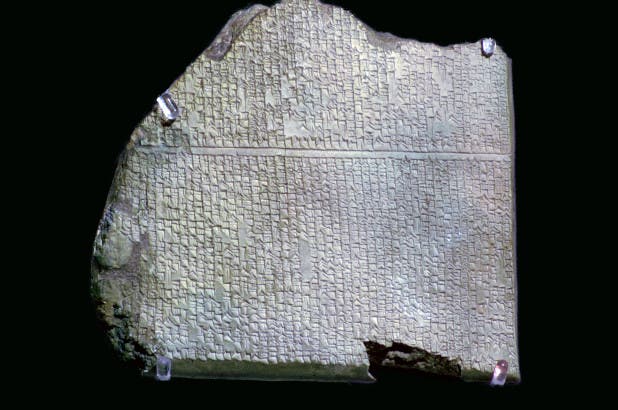The tablet, which currently lies in the British Museum, is one of the most famous clay tablets in the world. In served as inspiration for the biblical Flood survived by Noah and his family — but it also involves quite the trickery.

Noah and his Ark play an important role in Christianity. In addition to being one of the most remarkable biblical tales, it inspired countless events and stories. But a discovery in 1872 showed that it too was inspired from an older story — a Babylonian story. The tablet uncovered by archaeologist George Smith almost 150 years ago tells a story that’s remarkably similar to Noah’s Flood.
In the story, the gods were angry with mankind and decided to flood and destroy the Earth. But one god, Enki (later known as Ea) decides to save mankind. He revealed the plan to Utu-napishtim, instructing him to build a large boat in which to save himself and his family. The God orders him to take into it birds and beasts of all kinds. Utu-napishtim obeyed, and when all were aboard, a huge flood started, covering everything in sight. After 12 days, Utu-napishtim opened the hatch to the boat, seeing Mount Nisir. He rested the ship there, releasing birds to see whether they would come back or not. When a raven did not return, it meant that the waters had receded and the bird found a place to rest, so the flood had ended.
If all that sounds horribly familiar, it’s because it’s almost exactly the way the Flood is described in the bible. The story is told in the Epic of Gilgamesh, the 4,000-year-old epic Mesopotamian poem.

The key element in this story (and pretty much the only difference to the bible) is the god Ea. Ea was the god of water, knowledge, crafts, but he was also the god of mischief; yes, Ea was also a trickster god. Although Utu-napishtim was cherished by all gods at the end of the flood and granted immortality, Ea would claim that he did not tell Utu-napishtim about the flood. Instead, the god claims he only made a large body of water appear in a dream — a claim which contradicts the earlier narrative of the poem and reveals an alternative telling.
This claim is discussed by Dr. Martin Worthington, who’s new research describes a wordplay in the story. This wordplay reveals the duplicitous language of the Babylonian god, who was motivated by self-interest. Dr. Worthington, a Fellow of St John’s College, University of Cambridge, said:
“Ea tricks humanity by spreading fake news. He tells the Babylonian Noah, known as Uta–napishti, to promise his people that food will rain from the sky if they help him build the ark. What the people don’t realise is that Ea’s nine-line message is a trick: it is a sequence of sounds that can be understood in radically different ways, like English ‘ice cream’ and ‘I scream’.
“While Ea’s message seems to promise a rain of food, its hidden meaning warns of the Flood. Once the ark is built, Uta–napishti and his family clamber aboard and survive with a menagerie of animals. Everyone else drowns. With this early episode, set in mythological time, the manipulation of information and language has begun. It may be the earliest ever example of fake news.”
Ea’s lines use a verbal trick. It sends a message which can be understood in different ways that are phonetically identical. So while it could seem that Ea is foretelling a “rain of food”, there are several insinuations hinting at impending catastrophe.
“Ea is clearly a master wordsmith who is able to compress multiple simultaneous meanings into one duplicitous utterance.”
It’s hard to discuss wordplays in other languages, but here is an example of what’s involved:
The Babylonian lines go:
ina lilâti ušaznanakkunūši šamūt kibāti
ina šēr(-)kukkī
The positive-sounding “plain” interpretation sounds like this:
At dawn there will be kukku-cakes,
in the evening he will rain down upon you a shower of wheat.
But the same thing could be interpreted thusly:
By means of incantations,
by means of wind-demons, he will rain down upon you rain as thick as (grains of) wheat.
or:
At dawn, he will rain down upon you darkness,
(then) in (this) pre-nocturnal twilight he will rain down upon you rain as thick as (grains of) wheat.
Simply put, the positive reading is ‘at dawn there will be cakes’, and the negative reading warns of the flood.
Worthington is an Assyriologist who specialises in Babylonian, Assyrian and Sumerian grammar, literature and medicine. In his new book titled Ea’s Duplicity in the Gilgamesh Flood story, he explores the tricks of ‘wily Ea’.
But there’s still one question left to answer: why would Ea go through all this trouble? Well, the gods were decided to wipe humanity clean off, but gods are often reckless. In Babylonian mythology, gods also need people to survive. Ea may have been a trickster, but he realized that simply destroying humanity was a bad decision, so he decided to take matters into his own hands, while also denying involvement.
“Babylonian gods only survive because people feed them. If humanity had been wiped out, the gods would have starved. The god Ea manipulates language and misleads people into doing his will because it serves his self-interest. Modern parallels are legion!”






